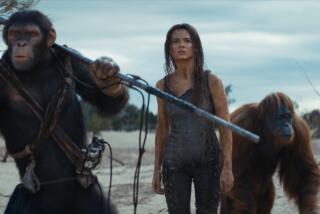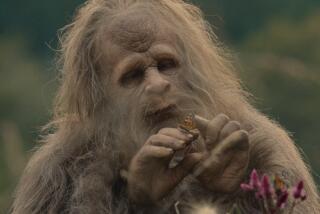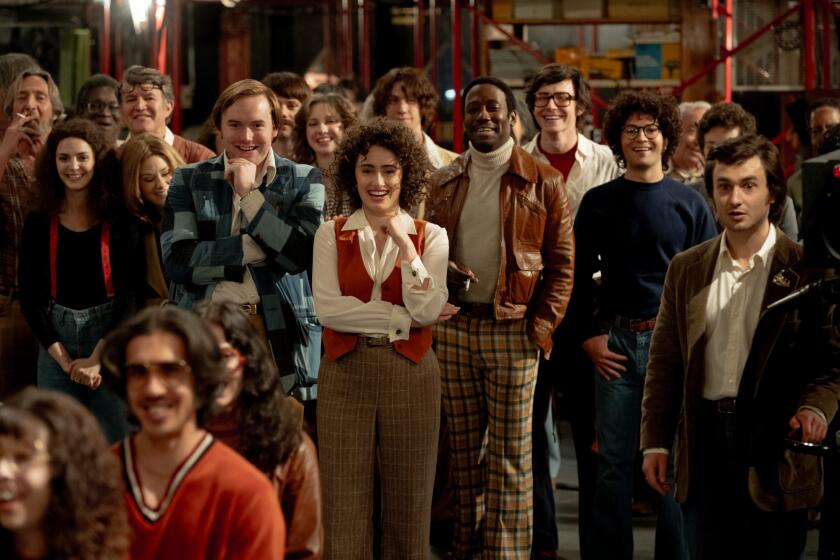Review: ‘Dawn of the Planet of the Apes’ is a visual feast

Kenneth Turan reviews ‘Dawn of the Planet of the Apes’ starring Andy Serkis, Jason Clarke, Gary Oldman and Keri Russell.
If you want apes, you’ve come to the right place. If people are your passion, not so much.
That, in a nutshell, is the verdict on “Dawn of the Planet of the Apes,” the sequel to 2011’s “Rise of the Planet of the Apes,” the splendid rebooting of the saga of species in conflict that has been a pop-culture staple for nearly 50 years.
------------
FOR THE RECORD
“Dawn of the Planet of the Apes”: In a review of the film “Dawn of the Planet of the Apes” in the July 10 Calendar section, actress Keri Russell’s first name was misspelled as Kerri.
------------
With Andy Serkis in top form as Caesar, the he-who-must-be-obeyed ayatollah of apedom, and Joe Letteri (a four-time Oscar-winner) and Dan Lemmon returning as well as visual-effects wizards, “Dawn’s” vision of masses of intelligent apes swarming the screen as masters of all they survey is even more impressive than it was the last time around and reason enough to see the film all by itself.
But when it comes to telling the story of the ragtag bunch of humans who inevitably clash with the upwardly mobile apes, director Matt Reeves and screenwriters Rick Jaffa & Amanda Silver and Mark Bombach have not quite matched the élan of the previous film.
For one thing, likely envisioned as a bridge episode between the series starter and the next chapter’s cataclysmic showdown, “Dawn’s” story lacks the urgency and interest Jaffa & Silver’s script created the first time around.
Tepid lines like “Try not to speak, you need to rest” and the inevitable “I thought we had a chance” do not help matters, and neither does the lack of a human leading man with the energy of “Rise’s” James Franco or the charisma to match Serkis’ Caesar.
After a brief recap showing how the deadly simian flu all but wiped out humanity, “Dawn” starts, as well it might, inside Caesar’s domain, 10 years after the apes’ mass flight to Muir Woods across the Golden Gate Bridge from San Francisco that was one of the last film’s visual highlights.
Still mentored by ironic orangutan Maurice (Karin Konoval) and backed up by savage bonobo Koba (Toby Kebbell), Caesar is now a family man with an adolescent son named Blue Eyes (Nick Thurston) to guide to maturity.
Given that Caesar’s followers have grown in number from 50 to 2,000, the ability of motion-capture technology to bring this larger universe to life is critical, and the technicians at Weta Digital have been up to the task.
The apes are played by an increasing number of actors (or parkour performers inside motion-capture suits), which helps with verisimilitude, especially when apes on horseback make an imposing appearance. Also new is the ability to shoot a huge chunk of the film not only in 3-D but in outdoor locations in Vancouver, Canada; and New Orleans.
One of “Dawn’s” most impressive set pieces occurs early on, when an ape hunting party takes off against a herd of elk and also comes face to face with an exceptionally unhappy bear, resulting in some highly adrenalized fang-and-claw nature footage.
Then, as they must, a few puny humans appear. Lead by Malcolm (“Zero Dark Thirty’s” Jason Clarke) and compassionate nurse Ellie (Kerri Russell), they have been sent by their fellow survivors in a ruined San Francisco (finely created by production designer James Chinlund and his team) to find and repair a nearby hydroelectric dam whose energy is essential if the city is to survive.
Naturally, they are shocked to come across these obviously intelligent apes who even speak rudimentary English. When they report as much to Dreyfus, the city’s leader (an underutilized Gary Oldman), his paranoia is aroused and he fears for the worst.
Koba — not for nothing named after Joseph Stalin — is as mistrustful of humans as Dreyfus is of apes, which is not a good combination. As R. Crumb’s philosophical Mr. Natural used to say, “Twas Ever Thus.”
With its give-peace-a-chance plea for interspecies amity and its condemnation of needless mistrust, not to mention preemptive strikes, “Dawn of the Planet of the Apes” places itself squarely on the side of the angels, but in the process risks being more earnest than is good for it.
Which is why the film is so fortunate to have Serkis, whose work here and as Gollum in the “Lord of the Rings” and “Hobbit” films turns motion capture into an art form all by himself. He and his fellow mo-cap actors truly make us believe we are watching intelligent apes in action, and that is not something you see every day.
------------
‘Dawn of the Planet of the Apes’
MPAA rating: PG-13, for intense sequences of sci-fi violence and action, and brief strong language
Running time: 2 hours, 10 minutes
Playing: In general release
More to Read
Only good movies
Get the Indie Focus newsletter, Mark Olsen's weekly guide to the world of cinema.
You may occasionally receive promotional content from the Los Angeles Times.











